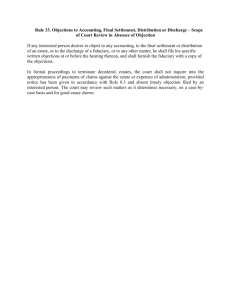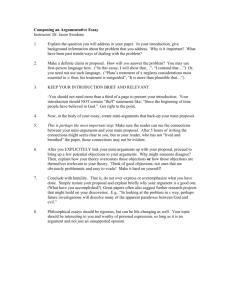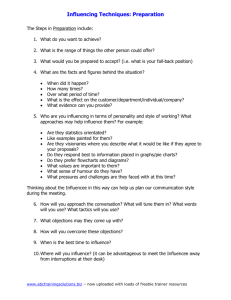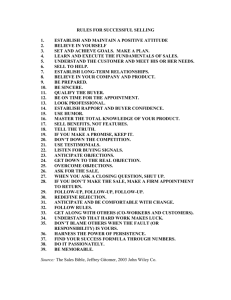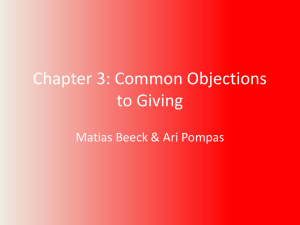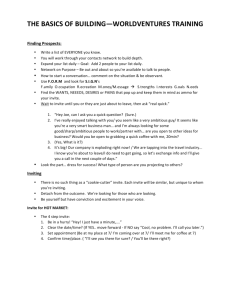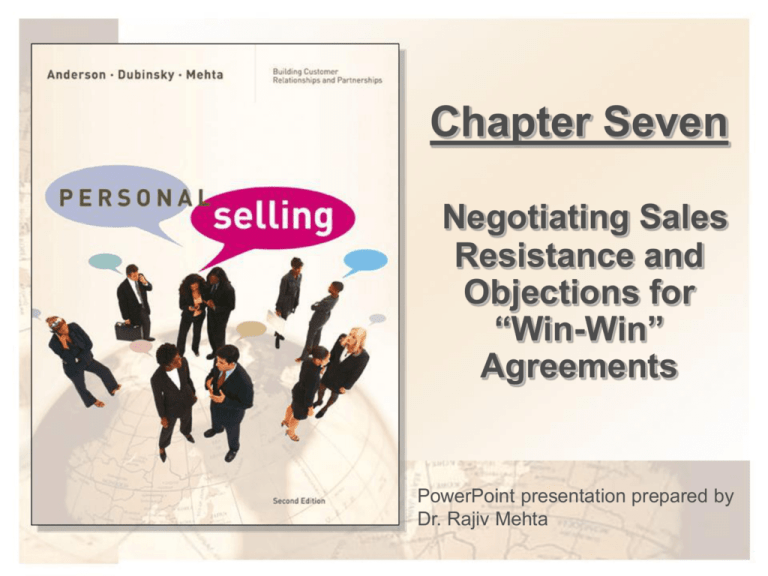
Chapter Seven
Negotiating Sales
Resistance and
Objections for
“Win-Win”
Agreements
PowerPoint presentation prepared by
Dr. Rajiv Mehta
Chapter Outline
• What are buyer objections and resistance?
• Planning for objections
• Different forms of objections
• Identifying and dealing with the prospect’s key objection
• Negotiating with prospects and customers
• Specific techniques for negotiating buyer objections
• A major nemesis: price resistance
Copyright © Houghton Mifflin Company. All rights reserved.
Chapter 7 | Slide 2
Learning Objectives
After reading this chapter, you should understand:
• Why objections and sales resistance are
important to personal selling.
• How to plan for objections.
• The various forms of buyer resistance and
objections.
• How to deal with prospect resistance.
• The importance of win-win negotiation
outcomes.
• How to overcome objections to price.
Royalty-Free, Digital Vision/Getty Images
• Techniques for negotiating resistance and
objections.
Copyright © Houghton Mifflin Company. All rights reserved.
Chapter 7 | Slide 3
Figure 7.1:
The Personal Selling Process (PSP)
The fifth step of the
professional selling
cycle
Copyright © Houghton Mifflin Company. All rights reserved.
Chapter 7 | Slide 4
What Are Buyer Objections
and Resistance? (cont.)
• Objections are statements, questions, or
actions by the prospect that indicate
resistance or an unwillingness to buy . . .
at least not yet
Royalty-Free, Digital Vision/Getty Images
• Without sales resistance, there wouldn't be any
need for salespeople
• The first person who reached the prospect
would make the sale
• Serious negotiations seldom begin until the
prospect's objections surface
Copyright © Houghton Mifflin Company. All rights reserved.
Chapter Review
Question:
What do we mean by
“buyer objections and
resistance”?
Chapter 7 | Slide 5
What Are Buyer Objections
and Resistance? (cont.)
Reasons for Objections
• Prospects and customers raise objections for myriad reasons:
• People will almost always raise objections, even
if they are totally sold on the product
• The prospect may seek reassurance that the
product will perform as promised
Royalty-Free, Digital Vision/Getty Images
• The prospect may have been trained to raise objections as a matter of
buying technique or negotiation strategy
• The prospect may lack the authority to buy but covers up this fact by
raising several smokescreen objections
Copyright © Houghton Mifflin Company. All rights reserved.
Chapter 7 | Slide 6
What Are Buyer Objections and
Resistance? (cont.)
Reasons for Objections
• A few prospects will raise objections merely to be an irritant
to salespeople or have fun seeing them work for the order
• An objection may actually be an appeal by the prospect for
assistance in justifying a decision to buy
• Some prospects raise objections so that they can bargain for
a better deal. Irrespective of how low your price might be
compared to competition, some prospects are obsessed
about getting an even lower price so that they can feel
“victorious”
• Prospects may raise an objection because they have a bias
against the salesperson’s company or product type or, in rare
cases, simply dislike the salesperson
Copyright © Houghton Mifflin Company. All rights reserved.
Chapter 7 | Slide 7
What Are Buyer Objections and
Resistance? (cont.)
Signs of Interest
• Objections are often indirect ways for prospects to say that
they want to know more. One study found that salespeople
had a 10 percent higher success rate when buyers raised
objections than when they seemed to have none.
Nonverbal Resistance
• When salespeople spot passive resistance such as
frowning, glancing at one’s watch, or playing with a desk
accessory, they must find some way to perk up the
presentation and get the prospect involved.
Copyright © Houghton Mifflin Company. All rights reserved.
Chapter 7 | Slide 8
Planning for Objections
• One of the best ways to minimize objections is to learn what the
prospect’s objections are before you begin the sales presentation
• In planning for buyer resistance or objections, you should keep a
running file of the most typical objections:
• Develop a master list of prospect objections and
classify them according to type, such as product,
price, delivery, installation, service, and company.
• Include successful and unsuccessful ways of
dealing with each objection.
• Tap sales colleagues’ knowledge about various
types of prospect resistance and successful
methods for dealing with each.
Chapter Review Question:
What steps are involved in planning for
prospect objections?
© Royalty-Free/CORBIS
Copyright © Houghton Mifflin Company. All rights reserved.
Chapter 7 | Slide 9
Different Forms of Objections (cont.)
•
Sales resistance can be categorized into either valid or invalid objections.
Valid Objections:
•
Valid objections are sincere concerns that the prospect needs answered before
he or she is willing to make the commitment to buy.
Invalid Objections:
•
•
•
Invalid objections are merely defense mechanisms used by prospects to stall,
slow down, or prevent the sales process from proceeding.
Invalid objections are typically irrelevant, untruthful, delaying, or latent reasons
for the prospect’s unwillingness to negotiate.
They are difficult to identify and overcome because the prospect does not deal
with the salesperson in a straightforward, honest manner.
Chapter Review Question:
How can a salesperson distinguish between valid and invalid objections?
Copyright © Houghton Mifflin Company. All rights reserved.
Chapter 7 | Slide 10
Different Forms of
Valid Objections (cont.)
1.
Product Objections
•
Product objections are usually concern the features, advantages, and
benefits associated with a product or service. When prospects use this form
of resistance to purchasing, salespeople should provide additional
information to reassure them.
2.
Price Objections
•
Price objections are the most frequently raised form of initial resistance. To
counter price resistance, salespeople must show that their product or
service offers the prospect higher value per dollar spent than competitive
offerings.
3.
Promotion Objections
•
Promotion objections are commonly used as a resistance tactic when the
seller is known not to promote products aggressively. To overcome this
resistance, salespeople may have to offer buyers promotional allowances or
cooperative advertising arrangements, special rebates, or purchase
incentives.
Copyright © Houghton Mifflin Company. All rights reserved.
Chapter 7 | Slide 11
Different Forms of
Valid Objections (cont.)
4.
Distribution Objections
•
Distribution objections typically involve the physical movement of
products through the channels of distribution. These forms of buyer
resistance include concerns about long delivery time, high delivery costs,
and large-quantity stocking requirements.
5.
Capital Objections
•
Capital objections generally revolve around budgetary issues that
prospects give as an excuse for not purchasing products now. This
resistance tends to increase with the price of the product or service.
6.
Source Objections
•
Source objections may result from negative publicity about unethical,
illegal, or inefficient business practices by the seller. Conversely, the
seller company may not be well enough known for the prospect to feel
comfortable purchasing from it. Source objections also can result from
the prospect’s loyalty to a competing firm.
Copyright © Houghton Mifflin Company. All rights reserved.
Chapter 7 | Slide 12
Different Forms of
Valid Objections (cont.)
7.
Needs Objections
•
Needs objections are raised by prospects who feel they simply do not
currently need or have use for the products or services being offered.
Handling “no need” objections requires innovative approaches by
salespeople to educate prospects on the potential benefits to be derived
from purchasing their products.
Copyright © Houghton Mifflin Company. All rights reserved.
Chapter 7 | Slide 13
Different Forms of
Invalid Objections (cont.)
1. Latent Objections
• Latent objections are hidden and sometimes too personal or
embarrassing for the prospect to reveal, so they remain unspoken.
2. Stalling Objections
• Stalling objections are usually delaying tactics articulated by such
comments as “Around here, all decisions are shared, so just leave
your product literature for us to look over, and we’ll get back to you
if we’re interested.” It is usually a waste of time to attempt to
overcome repeated prospect objections that appear invalid.
Copyright © Houghton Mifflin Company. All rights reserved.
Chapter 7 | Slide 14
Different Forms of Objections
3. Time Objections
•
Time objections are delaying tactics that usually surface in
prospect statements such as “I’ve got to prepare for a meeting in
ten minutes, so I don’t have time to talk now,” or “I’m just too busy
for the next several weeks with a special project to meet with you.”
4. Unethical Objections
•
Unethical objections include actions or attitudes that seem
unprincipled or immoral. Examples of unethical resistance to
buying include excuses about not doing business with a particular
ethnic group or religious persuasion, use of sexual overtures, and
soliciting bribes or kickbacks.
Copyright © Houghton Mifflin Company. All rights reserved.
Chapter 7 | Slide 15
Table 7.1 Types of Valid and
Invalid Objections
Copyright © Houghton Mifflin Company. All rights reserved.
Chapter 7 | Slide 16
Table 7.1 Types of Valid and
Invalid Objections (cont.)
Copyright © Houghton Mifflin Company. All rights reserved.
Chapter 7 | Slide 17
Table 7.1 Types of Valid and
Invalid Objections (cont.)
Copyright © Houghton Mifflin Company. All rights reserved.
Chapter 7 | Slide 18
Identifying and Dealing with the
Prospect's Key Objection
• Identifying and negotiating the prospect's
most important or key objection is the first
step to negotiating total prospect resistance
Royalty-Free, Digital Vision/Getty Images
• One subtle way to start is by engaging the prospect in informal
conversation before the sales presentation and encouraging him or her
to reveal personal concerns and perspectives on problems
Copyright © Houghton Mifflin Company. All rights reserved.
Chapter 7 | Slide 19
Figure 7.2:
Keystone in the Arch of Resistance
Copyright © Houghton Mifflin Company. All rights reserved.
Chapter 7 | Slide 20
Identifying and Dealing with the
Prospect's Key Objection
Process for Uncovering and Overcoming Objections
1. Start with the proper attitude
2. Uncover the objection
3. Clarify the objection
4. Acknowledge the objection
5. Handle the objection
Copyright © Houghton Mifflin Company. All rights reserved.
Chapter 7 | Slide 21
Table 7.2 Process for Uncovering and
Overcoming Objections
Copyright © Houghton Mifflin Company. All rights reserved.
Chapter 7 | Slide 22
Table 7.2 Process for Uncovering and
Overcoming Objections (cont.)
Copyright © Houghton Mifflin Company. All rights reserved.
Chapter 7 | Slide 23
Identifying and Dealing with the
Prospect's Key Objection (cont.)
Sell the Prospects on the Benefits
• Prospects may use many sales resistance
tactics, but by emphasizing the bundle of
benefits that the prospect will derive from the
product, salespersons can resolve many
objections or push them into the background.
• Salespeople must remember to cover
intangible benefits as well as tangible ones.
Stressing the product’s bundle of specific
benefits can usually overcome most
objections.
Royalty-Free, Digital Vision/Getty Images
Copyright © Houghton Mifflin Company. All rights reserved.
Chapter 7 | Slide 24
Identifying and Dealing with the
Prospect's Key Objection (cont.)
•
Some general rules for helping salespeople successfully negotiate
prospect and customer objections are as follows:
1.
Don’t be defensive about
objections.
2.
Make sure you understand the
objection.
3.
Don’t disparage the prospect’s
objection.
© Royalty-Free/CORBIS
4.
Never argue with a prospect. You don’t win sales by winning
arguments.
5.
Try to lead the prospect to answer his or her own objection.
Copyright © Houghton Mifflin Company. All rights reserved.
Chapter 7 | Slide 25
Identifying and Dealing with the
Prospect's Key Objection (cont.)
6.
Don’t over answer or belabor the point
because you risk insulting the prospect’s
intelligence.
7.
Don’t be drawn into pointless squabbles.
8.
Don’t try to fake an answer. Admit you
don’t know but promise that you’ll get
back promptly with the answer.
9.
Confirm your answers but don’t question
them by asking whether you’ve fully
answered the prospect’s question.
Royalty-Free, Digital Vision/Getty Images
Copyright © Houghton Mifflin Company. All rights reserved.
Chapter 7 | Slide 26
Figure 7.3: Flow-Chart Approach for
Handling Objections
Copyright © Houghton Mifflin Company. All rights reserved.
Chapter 7 | Slide 27
Negotiation
Royalty-Free, Digital Vision/Getty Images
• Negotiation refers to the “Mutual discussion and
arrangement of the terms of a transaction or agreement"
Copyright © Houghton Mifflin Company. All rights reserved.
Chapter 7 | Slide 28
Negotiation Strategies
• The best way to negotiate with prospects is to try to draw them into
creative, problem-solving partnerships by:
•
Focusing on issues where you and the
prospect have the most agreement.
•
Taking a relatively firm negotiating position
initially so that when you compromise, the
prospect will feel that he or she negotiated a
bargain.
•
Trying to avoid making the first concession
except on a minor point.
•
Keeping track of the issues resolved during the
discussion; use frequent recaps to confirm the
progress being made.
Royalty-Free, Digital Vision/Getty Images
Copyright © Houghton Mifflin Company. All rights reserved.
Chapter 7 | Slide 29
Negotiation Strategies (cont.)
•
Concentrating on problem-solving
approaches that satisfy the needs of both
the buyer and the seller
•
Agreeing to a solution only after it is
certain to work for both parties
•
Beginning negotiations with your highest
expectations in price and terms
•
Not allowing yourself to be emotionally
blackmailed into concessions
Royalty-Free, Digital Vision/Getty Images
Chapter Review Question:
Outline some basic negotiating strategies.
Copyright © Houghton Mifflin Company. All rights reserved.
Chapter 7 | Slide 30
Negotiation Outcomes
• Every sales negotiation has four possible outcomes:
1. Seller Win - Buyer Win
2. Seller Win - Buyer Lose
3. Seller Lose - Buyer Win
4. Seller Lose - Buyer Lose
• Only one of these, the "win-win” agreement, will further the business
relationship and set the stage for future sales agreements
Copyright © Houghton Mifflin Company. All rights reserved.
Chapter 7 | Slide 31
Negotiation Outcomes (cont.)
1. Seller Win - Buyer Win Agreements
•
This is the only outcome that leads to long-run success for
salespeople and the only outcome that professional salespeople
seek
2. Seller Win - Buyer Lose Agreements
•
When the buyer is dissatisfied, the business relationship is in
serious trouble
•
If a buyer feels manipulated or taken advantage of, he or she may
refuse to have anything more to do with the salesperson or the
company and sometimes may even seek to harm the
salesperson's relationships with other prospects and customers
Copyright © Houghton Mifflin Company. All rights reserved.
Chapter 7 | Slide 32
Negotiation Outcomes (cont.)
3. Seller Lose - Buyer Win Agreements
•
Salespeople will feel short-changed and may try to cut corners on
the service contract or get even in future negotiations – this
relationship is in trouble
4. Seller Lose - Buyer Lose Agreements
•
Both parties are dissatisfied so the bond of trust is probably
severed – future negotiations are unlikely
Chapter Review Question:
Describe the four possible outcomes in
any business negotiation.
Copyright © Houghton Mifflin Company. All rights reserved.
Chapter 7 | Slide 33
Figure 7.4:
Sales Negotiation Outcomes
Copyright © Houghton Mifflin Company. All rights reserved.
Chapter 7 | Slide 34
Table 7.3 General Rules for
Negotiating Objections
Copyright © Houghton Mifflin Company. All rights reserved.
Chapter 7 | Slide 35
Specific Techniques for
Negotiating Buyer Objections (cont.)
Various methods have been developed and tested to
handle prospect objections, which are classified under
five categories:
1. Put-off
2. Switch focus
3. Offset
4. Denial, and
5. Provide proof
Copyright © Houghton Mifflin Company. All rights reserved.
Chapter 7 | Slide 36
1. Put-Off Strategies (cont.)
1. I’m coming to that: put off things like price until the end
so you don’t turn off the prospect early
2.
Pass-off: keep a pleasant expression but say nothing
Copyright © Houghton Mifflin Company. All rights reserved.
Chapter 7 | Slide 37
2. Switch Focus Strategies (cont.)
1.
Alternative product: switch focus to another model
2.
Feel, felt, found: trace own experience with product
3.
Comparison or contrast: compare product with another
4.
Answer with a question: what do you think?
5.
Humor: use lighthearted humor to ease tension and redirect the
focus
6.
Agree and neutralize: give some level of agreement, then explain
benefit
Copyright © Houghton Mifflin Company. All rights reserved.
Chapter 7 | Slide 38
3. Offset Strategies (cont.)
1. Compensation or counterbalance: counter an objection
that cannot be denied by citing an even more important
buying benefit
2. Boomerang: turn the objection
into a reason for buying
© Royalty-Free/CORBIS
Copyright © Houghton Mifflin Company. All rights reserved.
Chapter 7 | Slide 39
4. Denial Strategies (cont.)
1. Indirect denial: agree with prospect’s objection but follow with a
disclaimer
2. Direct denial: tackle the false
rumor head-on
Royalty-Free, Digital Vision/Getty Images
Copyright © Houghton Mifflin Company. All rights reserved.
Chapter 7 | Slide 40
5. Provide Proof Strategies (cont.)
1. Case history: tell experience
of a satisfied customer.
2. Demonstration: dramatize
major advantages and
benefits.
Royalty-Free, Digital Vision/Getty Images
3. Propose trial use: offer free
trial use.
Chapter Review Question:
Give some basic techniques for handling objections in
each of the five categories discussed in the chapter.
Copyright © Houghton Mifflin Company. All rights reserved.
Chapter 7 | Slide 41
Table 7.4 Specific Techniques for
Negotiating Buyer Objections
Copyright © Houghton Mifflin Company. All rights reserved.
Chapter 7 | Slide 42
A Major Nemesis:
Price Resistance
• Most buyers are more concerned about relative value for
their money than absolute price
• Usually, a price objection means that the salesperson has
not convinced the buyer of the value of the product in
terms of its price
Perceived Valued = Perceived Benefits
Perceived Price
Chapter Review Question:
What do we mean by perceived value?
How do prospects determine perceived value?
Copyright © Houghton Mifflin Company. All rights reserved.
Chapter 7 | Slide 43
Value Analysis and Industrial Buyers
•
A value analysis shows how the salesperson's product is the best value for the
buyer or organization's money
•
There are 3 approaches to conduct a value analysis:
1.
Unit Cost
•
2.
Product Cost Versus Value
•
3.
Illustrate the product’s higher value (benefits) versus
its cost over time
Return on Investment
•
Royalty-Free, Photodisc/Getty Images
Breaking the overall cost of the product down into
smaller units
ROI refers to the amount of money expected from an
investment over and above the original investment
Chapter Review Question:
What are the three basic approaches to preparing and presenting a
value analysis, and how does each approach work?
Copyright © Houghton Mifflin Company. All rights reserved.
Chapter 7 | Slide 44
Price Resistance and “Reality”
• Professional salespeople recognize that prospects and
customers often raise price objections merely to try for a
better deal or to slow down the selling process.
• Prospects’ price resistance may well be a ploy to conceal
their real reason for not buying.
• By unveiling the prospect’s sales resistance, it is possible
to discern how critical price is to the buyer and which
selling strategy to employ to deal with that resistance
successfully.
Copyright © Houghton Mifflin Company. All rights reserved.
Chapter 7 | Slide 45
Key Terms
• Objection
• Anything that the prospect or customer says or does that impedes
the sales negotiations.
• Valid Objections
• Sincere concerns that the prospect needs addressed before he or
she will be willing to buy.
• Invalid Objections
• Irrelevant, untruthful, or delaying actions or hidden reasons for not
buying.
• Keystone Objection
• The customer's most important objection.
• Win-Win Negotiations
• Negotiations in which both parties feel satisfied with the outcome;
the only kind of negotiations that professional salespeople seek!
Copyright © Houghton Mifflin Company. All rights reserved.
Chapter 7 | Slide 46
Key Terms (cont.)
• Put-Off Strategies
• A set of strategies for handling a prospect’s objections that require
the salesperson to delay dealing with the objection initially.
• Offset Strategies
• A set of strategies for dealing with objections that uses the
technique of offsetting the objection with a benefit.
• Perceived Value
• A product’s value from the prospect’s perspective.
• Value Analysis
• A financial analysis, usually written, that shows how a product is the
best value for the money.
Copyright © Houghton Mifflin Company. All rights reserved.
Chapter 7 | Slide 47
Topics for Thought
and Discussion
1. Why are objections sometimes called the salesperson’s
best friends? Wouldn’t it be better for salespeople if
prospects had no objections to buying their products?
2. Explain the concept of the buyer’s “arch of resistance”
and the “keystone” objection.
3. Why is the term negotiation appropriate for describing
how the salesperson should handle prospect resistance
and objections?
4. Describe some ways in which a salesperson could
change the prospect’s perceived value for a product.
Copyright © Houghton Mifflin Company. All rights reserved.
Chapter 7 | Slide 48
Internet Exercises
1. Use an Internet search engine to find three firms that
specialize in negotiation training. Peruse their websites to
see if you can find some negotiation strategies, in
addition to those discussed in this chapter, that could be
used in personal selling.
2. Use Google or any other search engine to locate two
examples of negotiation strategies being demonstrated
using Flash or streaming video.
3. Use the Internet to find articles on negotiating sales
resistance. Identify and describe some guidelines for
handling objections besides those outlined in Table 7.2.
Copyright © Houghton Mifflin Company. All rights reserved.
Chapter 7 | Slide 49
Projects for Personal Growth
1.
Go to the Business Periodicals Index online or at your school
library or do a computer search to find five articles on business
negotiation. Read at least three of them, and then prepare a
list of guidelines that a salesperson might use. In class,
compare the list you developed with those developed by
classmates also given the same assignment.
2.
Ask four professional salespeople about their philosophies and
strategies in negotiating prospect objections and resistance.
Decide, on the basis of these discussions, whether they
believe in win-win or win-lose outcomes in negotiating with
prospects. Explain your reasons for making this judgment
about each salesperson.
Copyright © Houghton Mifflin Company. All rights reserved.
Chapter 7 | Slide 50
Projects for Personal Growth (cont.)
3. Ask three professional salespeople who each sell to
different customer categories what their favorite
techniques are for handling buyer resistance and
objections. Do the negotiating techniques differ with the
customer type? Why or why not?
Copyright © Houghton Mifflin Company. All rights reserved.
Chapter 7 | Slide 51
Case 7.1: Learning to Handle Prospect
Objections
1. Look at the two situations one at a time. In your opinion,
which of the three sales trainees seems to be on the best
track toward handling the objection in each situation?
How do you think the prospect will respond to the other
two sales reps’ approaches in each case?
2. Which one of these sales reps would you prefer to be
assigned to a territory where you were the sales
manager? Why?
Copyright © Houghton Mifflin Company. All rights reserved.
Chapter 7 | Slide 52
Case 7.1: Learning to Handle Prospect
Objections (cont.)
3. What overall advice would you give the sales reps to help
them in negotiating prospect objections or resistance
4. What do you think of the process of setting up a situation
via videotape, stopping the tape to let sales trainees
explain how they would deal with the situation, and then
showing how the sales rep actually dealt with the
situation?
Copyright © Houghton Mifflin Company. All rights reserved.
Chapter 7 | Slide 53
Case 7.2: Negotiating Price with a
Taskmaster
1. Should McGranahan’s lower the price to Bargain City by
another five cents? Should Johnson agree to take an
even lower commission to win the order?
2. How successful do you think Johnson, Barnhart, and
Harris were in negotiating price resistance during the
sales call? What types of techniques did Johnson,
Barnhart, and Harris use to negotiate resistance? Do you
think more persistence could have won the three-member
sales team the Bargain City order?
Case 7.2 is found online at
http://college.hmco.com/pic/andersonps2e.
Copyright © Houghton Mifflin Company. All rights reserved.
Chapter 7 | Slide 54
Case 7.2: Negotiating Price with a
Taskmaster (cont.)
3. Do you think it was a good idea to bring Ron Harris, the
district manager of DuraFlor, along to help make the sales
presentation to Bargain City? Why or why not?
4. How well overall did the sales team (Johnson, Barnhart,
and Harris) do in negotiating concessions? What, if
anything, should they have done differently?
5. What would you advise Chuck Johnson and Tom
Barnhart to say in responding to Mr. Schramm’s request
for another nickel cut in price to win the Bargain City
business?
Copyright © Houghton Mifflin Company. All rights reserved.
Chapter 7 | Slide 55


